| Photojournal
- 25
and 27 July 2006
Bracket
and rail
|
A week or so ago, in
my July 18 entry, I was having fun with macrophotography (or macro
photography—take your pick) and contemplating doing more
of it. After thinking about it a little, I went and ordered some
special macro equipment: a focussing rail and a macro bracket.
On the 25th, the equipment arrived, and I went out around the
building after work to test it out.
A focussing rail is
a device that one inserts between the tripod head and the camera.
By turning the knob on the rail, one can move the camera forward
or backwards (towards the subject or away from it) with very precise
control. Because the distances involved with macrophotography
are so small, one needs precision. For instance, in the young
grasshopper below, I wanted to focus right on the insect's eyes.
After I set up my tripod and camera, I was able to turn the focus
ring on the lens to get pretty close to the focus I wanted. But
it wasn't quite right and by turning the focus ring more I would
have overshot or undershot proper focus—at least, that is
what was happening before. By using the focussing rail, though,
I was able to move the camera a distance on the order of half
a millimeter and get the focus exactly as I wanted it.
|
|
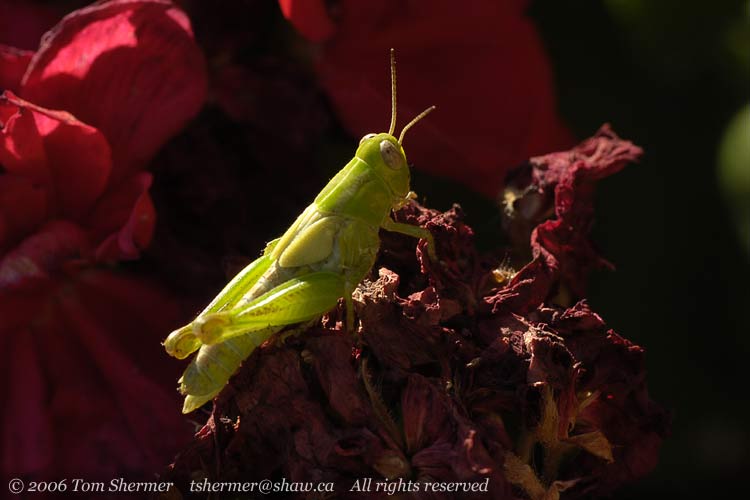 |
|
Some drawbacks with
the focussing rail are that it takes extra time to adjust, and
it requires the use of a tripod. The grasshopper was being polite,
in that he didn't jump away, but I missed many insect shots trying
to get my tripod in place and camera focussed.
By the way, those aren't
cloves of garlic stuck to the side of that grasshopper. Those
are his wing buds; in a later stage of development those become
his wings. That said, garlic-flavored grasshoppers might be a
good thing; you never know until you try. Maybe they'd be a hit
with the frogs.
Here's another insect,
a grey fly of some sort. In this one, I missed the focus and he's
not anywhere near as sharp as I'd like. I was hurrying to get
the shot before he flew off.
|
|
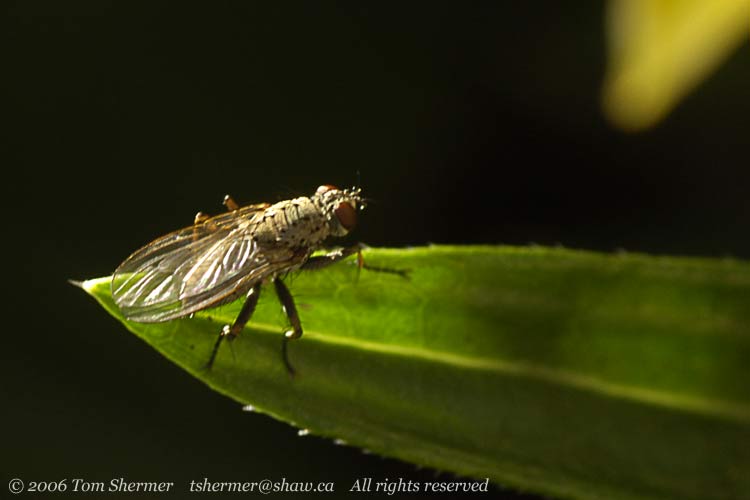 |
|
Half- or quarter-millimeter
precision for focus means that if there is even a slight breeze,
you could be in for trouble, especially with insects perched on
plants.
The rail really helps
when the subjects are smaller. Here's a photo of an aphid on a
flower stem. This little critter is itself only two or three millimeters
across. I don't think I would've been able to get this sort of
photo without the rail...at least not without taking a whole slew
of photos and hoping that one would end up in focus.
|
|
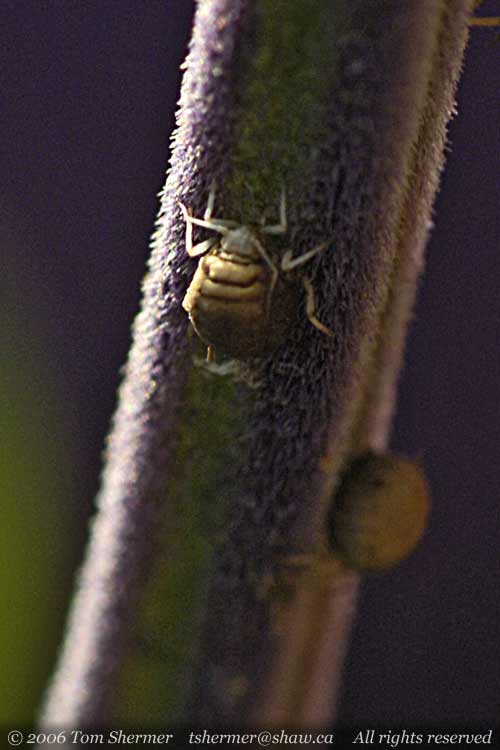 |
|
Luckily, aphids don't
move too much, so I could take my time getting that photo.
My other new macro
acquisition was a macro flash bracket; this is used for holding
a flash unit. The one I got also inserts between the tripod head
and the camera, or between the tripod head and the focussing rail,
as the case may be. It basically consists of a long metal arm
that one can adjust to different positions, with a mounting screw
that can slide up or down the arm for attaching the flash. Without
the bracket, one normally mounts a flash right on top of the camera.
With the bracket, one can place the flash closer to the subject,
getting more light on it, and also place it to the side or below,
avoiding 12-o'clock lighting.
Flash is used alot
with macrophotography, because the more light you have, the smaller
you can set the aperture on the camera, and the smaller the apeture,
the more of the photo is in focus. So here's a shot using the
flash on the bracket; both the ant and the upper aphids are in
decent focus.
|
|
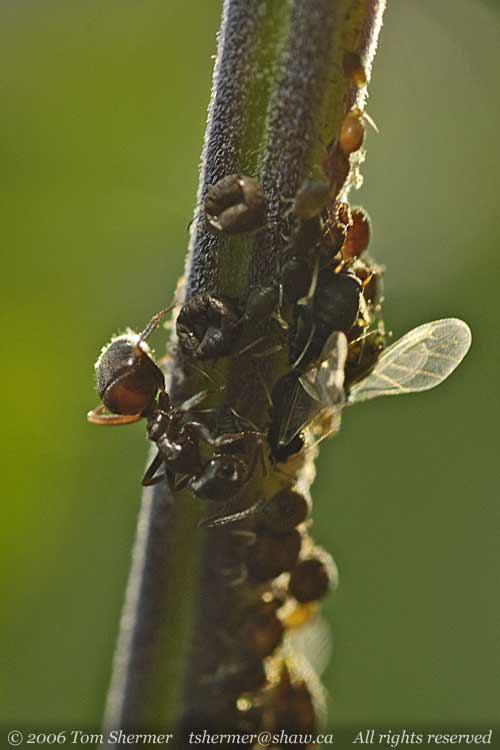 |
|
That photo still seems
a bit dark and imperfect, though, but it was my first day with
the new gear and I was still learning.
By the way, the ant
there is tending to the aphids. Aphids attached to flowers like
this secrete a sugary substance, and the ants really like eating
it. So the ants tend to aphids like they were little flocks of
sheep. They'll protect the aphids from aphid predators, such as
ladybugs.
|
|
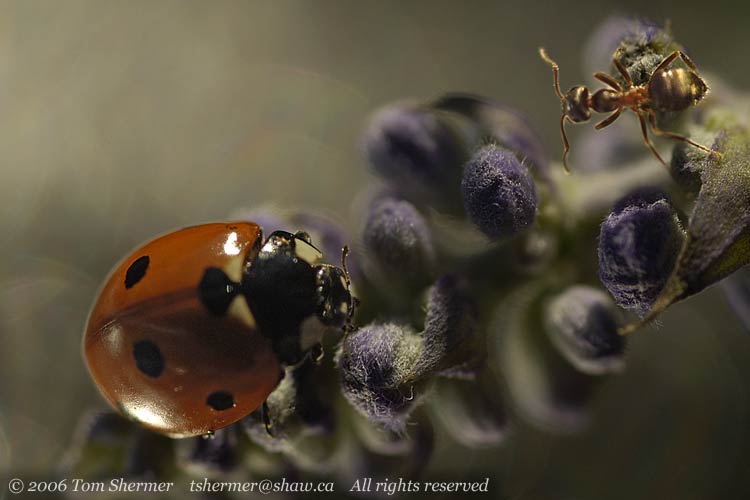 |
|
I watched a few ants
go after this ladybug...crawling over her, maybe pincing or biting
or something, and the ladybug moving pretty fast to try to get
away from them. I didn't get any photos of that, though; I wasn't
able to get the camera in place and focussed quick enough as the
action was really moving. (If they move even one centimeter, or
a half, I have to reorient the camera, and with rail, bracket,
and flash, it's heavy and hard to rotate precisely...maybe a gimbal
head would help...)
Here's a later shot
of ants and aphids, which I got better lighting but worse focus
on. I was focussing on the ant, and I got him fairly well, but
the blurry aphids right above him are a bit distracting. To get
good focus on everything here, I should have had the camera more
perpendicular to the flower stem. That's yet another thing to
think about (and do precisely) for macro. It's pretty exacting
work.
|
|
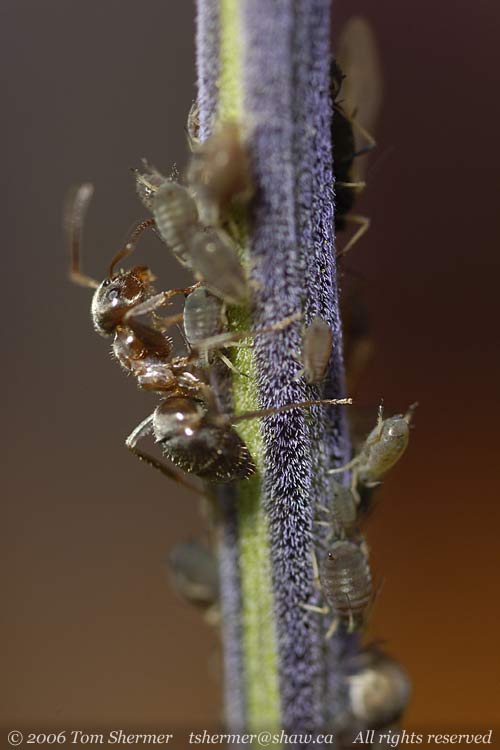 |
|
I liked the aphid on
the right, about level with the bottom of the ant. He looks like
he was just filled with helium and is almost floating away.
That was about it for
the 25th; on the 27th I again went out after work, hoping to do
a better job of ants and aphids. I was pleasantly surprised to
find a stink bug crawling around the flowers. I haven't ever noticed
any stink bugs around here before. This fellow is a Conspersus
Stink Bug, Euschistus conspersus.
|
|
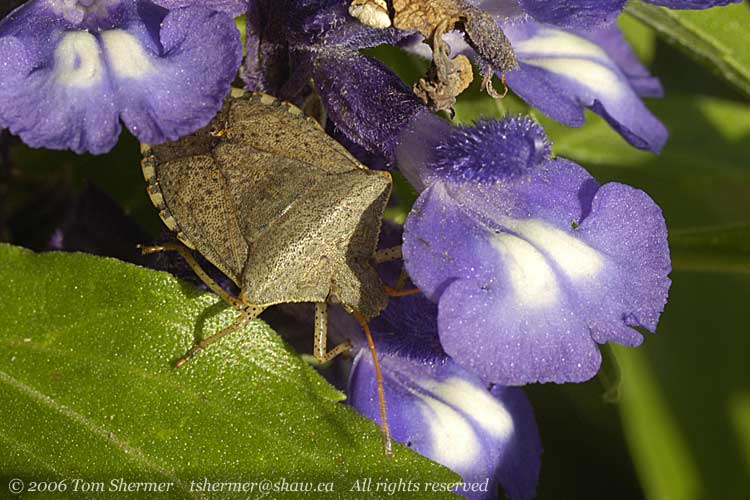 |
|
He was in strong sunlight
and I was able to get photos without using the flash.
As you can see here,
he's got orange antennae, a yellow-green underside and spotted
legs.
|
|
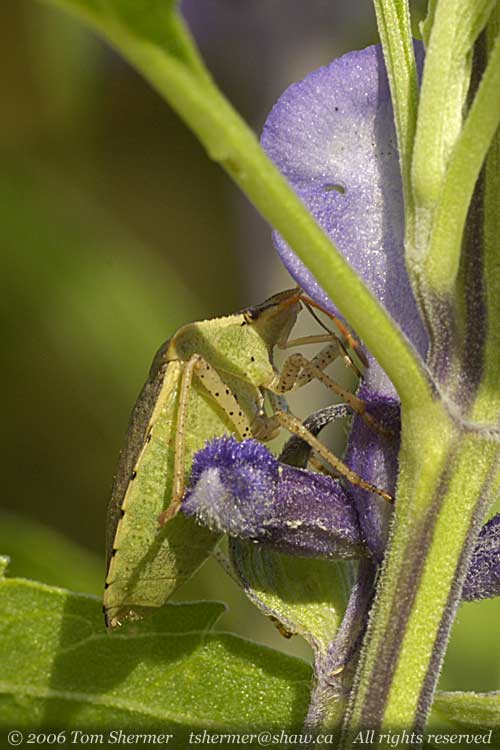 |
|
The flower he's climbing
on is the same type that the aphids, ladybug, and ants were on...Salvia
farinacea, or Victoria Blue Salvia. (And thanks to my pal
Jodi for supplying me with that plant ID.)
Here I was able to
get focus right on his head.
|
|
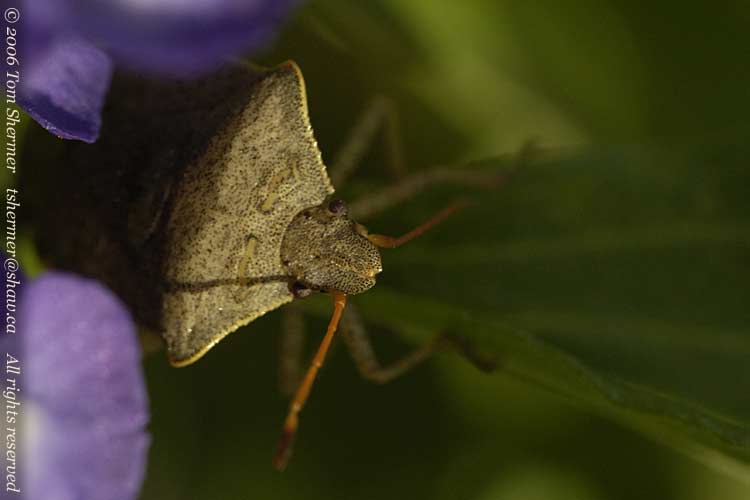 |
|
I moved on to other
subjects, going back to the aphid-infested flowers. I found inert
husks of aphids where two days ago live, plant-sucking aphids
flourished.
I had also learned
my lesson and did a better job of setting the camera perpendicular
to the subject.
|
|
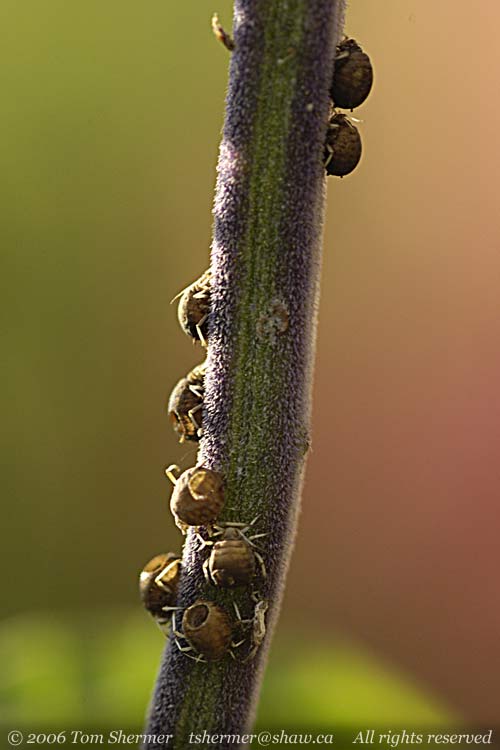 |
|
The aphids had pupated
and moved on. The remnant outer shells were pretty neat, and looked
to me like tiny beer barrels with legs.
It was laborious using
the tripod and rail to set up photos like the one above, and I
decided to free myself a little and take some handheld shots.
With the good light I had I was able to have a small aperture
and thus focus wasn't as critical. I moved in close on some bees.
This one's an Anthidium
bee, nectaring on the Salvia.
|
|
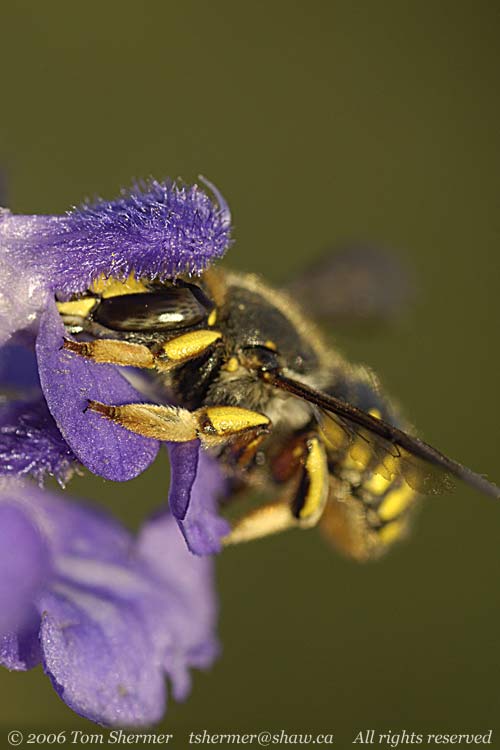 |
| And here's
a Honeybee at a smaller flower. |
|
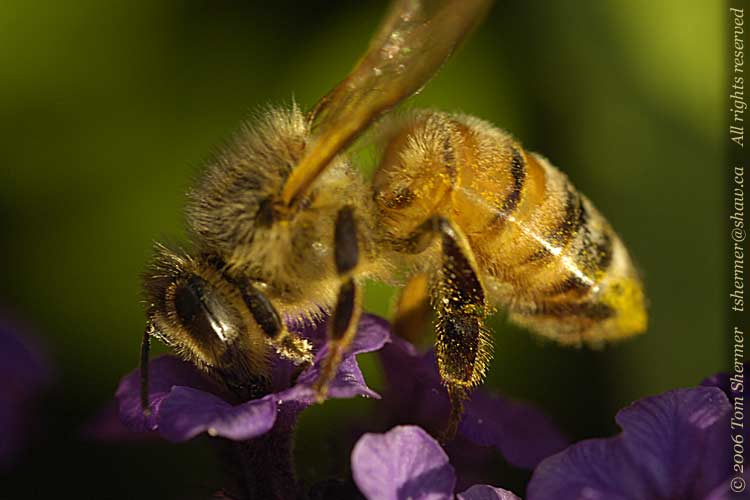 |
|
I love the detail that
macro can give.
As the sun set, I headed
back inside to check out and analyze the evening's photos.
I found that I still
have a lot of learning to do, and knew that I need to get a lot
more familiar with the new gear. So I continued to experiment
with it...but those experiments will be the subject of the next
few entries. I'll try not to bore you with too much photography
talk through it all.
Bracketed and railing,
Tom
|
|
|